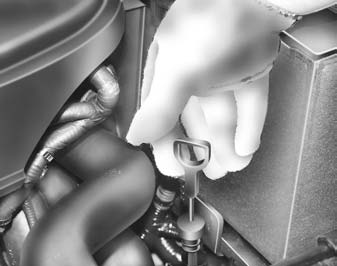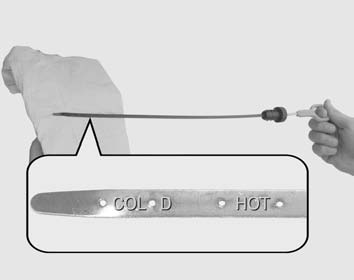Automatic transaxle

Checking the automatic transaxle
fluid level
The automatic transaxle fluid level
should be checked regularly.
Keep the vehicle on the level ground with the parking brake applied and check the fluid level according to the following procedure.
1. Place the selector lever in N (Neutral) position and confirm the engine is running at normal idle speed.
2. After the transaxle is warmed up sufficiently (fluid temperature 158~176°F (70~80°C)), for example by 10 minutes usual driving, shift the selector lever through all positions then place the selector lever in N (Neutral) or P (Park) position.

3. Confirm that the fluid level is in “HOT” range on the level gauge. If the fluid level is lower, add the specified fluid from the fill hole. If the fluid level is higher, drain the fluid from the drain hole.
4. If the fluid level is checked in cold condition (fluid temperature 68~86°F (20~30°C) add the fluid to “COLD” line and then recheck the fluid level according to the above step 2.
WARNING - Transaxle fluid The transaxle fluid level should be checked when the engine is at normal operating temperature. This means that the engine, radiator, radiator hose and exhaust system etc., are very hot. Exercise great care not to burn yourself during this procedure.
CAUTION
• Low fluid level causes transaxle
shift slippage. Overfilling can
cause foaming, loss of fluid and
transaxle malfunction.
• The use of a non-specified fluid could result in transaxle malfunction and failure.
WARNING - Parking brake To avoid sudden movement of the vehicle, apply parking brake and depress the brake pedal before moving the shift lever.
NOTICE
“COLD” scale is for reference only and
should NOT be used to determine
transaxle fluid level.
New automatic transaxle fluid should be red. The red dye is added so the assembly plant can identify it as automatic transaxle fluid and distinguish it from engine oil or antifreeze. The red dye, which is not an indicator of fluid quality, is not permanent. As the vehicle is driven, the automatic transaxle fluid will begin to look darker. The color may eventually appear light brown.
NOTICE
Have an Authorized Kia dealer inspect
or change the automatic transaxle fluid
according to the Scheduled
Maintenance at the beginning of this
section.
See also:
Tailgate
Opening the tailgate
• The tailgate is locked or unlocked
when all doors are locked or unlocked
with the key, transmitter or central door
lock switch.
• If unlocked, the tailgate can be ope ...
Maintenance schedule
Chart symbols:
I- Inspect these items and their related parts. If necessary, correct, clean,
refill, adjust or replace.
R- Replace or change
L- Lubricate.
(1) Refer to the lubricant and co ...
Power steering fluid
Checking the power steering fluid level
With the vehicle on level ground, check
the fluid level in the power steering reservoir
periodically. The fluid should be
between MAX and MIN marks on the ...


